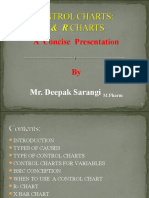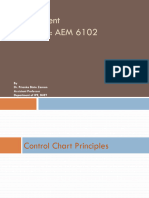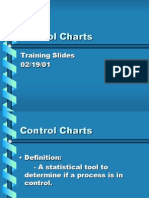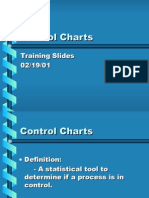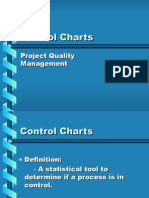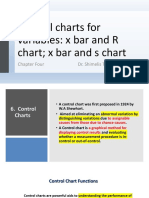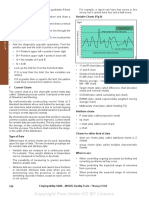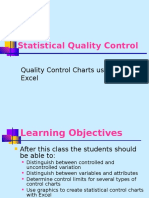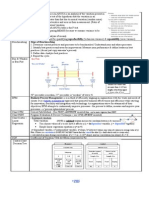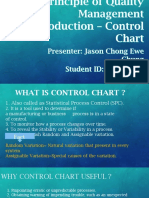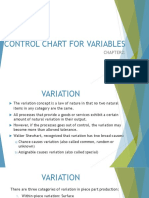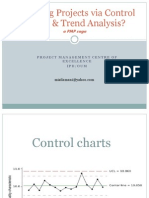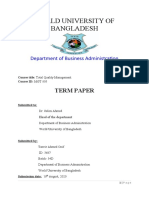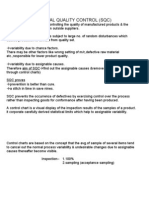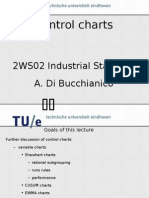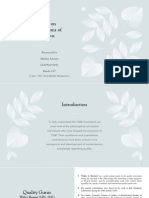HOW TO USE MINITAB:
QUALITY CONTROL
Noelle M. Richard
08/27/14
* Click on the links to
INTRODUCTION jump to that page in
the presentation. *
Two Major Components:
1. Control Charts
Used to monitor a process and show if it’s in control
Does not indicate if your process is meeting
specifications
2. Capability Analysis
Indicates whether your process is meeting
specifications
Does not show if your process is in control or not
For more details, go here: 2
\\Csdlnet\services\FS5-Projects\MCM-D\PERSONAL FOLDERS\Student Folders\N. Richard\SPC\Statistical Process Control (SPC).pptx
http://www.isixsigma.com/wp-content/uploads/2013/02/four-process-states.gif
* Click on the links to
jump to that page in
TYPES OF CONTROL CHARTS the presentation. *
Chart Use This Chart When…
You have… You have… You want to find…
Xbar – R Chart One Variable- Measurement
Data
A sample at each time t.
Samples can be different
Out of control signals, large
process shifts (≥ 1.5σ)
sizes
Xbar – S Chart One Variable- Measurement
Data
A sample at each time t.
Samples can be different
Out of control signals, large
process shifts (≥ 1.5σ)
sizes.
I – MR Chart One Variable- Measurement
Data
Individual measures (sample
size =1) at each time t
Out of control signals, large
process shifts (≥ 1.5σ)
EWMA Chart One Variable- Measurement
Data
Either samples or individual
measures at each time t
Out of control signals, small
process shifts (< 1.5σ)
CUSUM Chart One Variable- Measurement
Data
Either samples or individual
measures at each time t
Out of control signals, small
process shifts (< 1.5σ)
P Chart Attribute (Categorical) Data A sample at each time t.
Samples can be different
The fraction of non-
conforming units p, large
sizes process shifts (≥ 1.5σ)
C Chart Attribute (Categorical) Data Samples that are all the same
size
The # of non-conformities in
a sample, large process
shifts (≥ 1.5σ)
U Chart Attribute (Categorical) Data Samples that differ in size The # of non-conformities
per unit in a sample, large
process shifts (≥ 1.5σ)
T2 Chart Several Variables-
Measurement Data
A sample at each time t, for
each variable- considering
Out of control signals, large
process shifts (≥ 1.5σ),
variables jointly, rather than 3
separately
σ = standard deviation
PARTS OF A CONTROL CHART Control charts are used to detect
special causes of variation.
A process is out of control (OOC)
if it is operating with special
causes of variation.
See the next slide for signals of
an OOC process.
Shows which out of
control signal occurred
Variation caused by something
special, such as operator error,
Example of natural
equipment failure, etc. This is
(common)
not normal and not ok.
variation. This is
normal and ok.
Upper Control Limit
Displays
sample
means
Centerline
Lower Control Limit
Displays
sample
ranges
Return to Types of Control Chart
OUT OF CONTROL SIGNALS
Your process may be out of control (OOC) if one or more of the
following occurs:
1. One or more points beyond 3 sigma from center line
2. 9 points in a row on same side of center line
3. 6 points in a row, all increasing or all decreasing
4. 14 points in a row, alternating up and down
5. 2 out of 3 consecutive points beyond 2 sigma from center line (same side)
6. 4 out of 5 consecutive points beyond 1 sigma from center line (same side)
7. 15 points in a row within 1 sigma of center line (either side)
8. 8 points in a row beyond 1 sigma from center line (either side)
You can change the values in red, but the ones above are standard in practice.
Will show later how to perform these tests.
If you have an in control, normally distributed process, 99.73% of the points will fall within 3 sigma limits. 0.27% will fall outside the limits;
these points are called false alarms. They appear to be out of control signals, but they are not.
If your data is not normally distributed, you have a greater risk of false alarms. Even more important, you also have the risk of false 5
negatives. This is a point that is out of control, but is not flagged. This is bad!
Return to Types of Control Chart
CREATING CONTROL CHARTS
Two ways to create control charts in Minitab
1. Stat Control Charts
2. Assistant Control Charts
Note: Assistant only performs
tests 1, 2, and 7 from page 5 6
Return to Types of Control Chart
Graphs subgroup means and ranges
XBAR-R CHART Subgroup size: the
number of data points
in each of your samples.
If all your samples are the same size, you can enter in the number here.
If samples are not the same size, create a “Subgroup” column in your data.
The subgroup column should indicate what sample a data point belongs to.
To select which tests (for out of
control signals) to perform, click
Options.
Then, click the Tests tab.
Select which tests you want to
perform, or use the drop-down to
select “Perform all tests for special
causes”
7
Change the values if you wish.
Return to Types of Control Chart
XBAR-R CHART
To display ±1, ±2, ±3, etc. standard deviations on
your graph, go to the S-Limits tab
Sometimes, you will have data taken on different
days. You may want to see separate analysis for
each day.
Or, you purposely shift a process. The control limits
should be re-evaluated, and you may want to see the
change in limits.
Or, you want to monitor short production runs
(frequent product changeover, or, a part going
8
through several processes)
Using stages will allow you to do this. Control limits
will be re-evaluated at the beginning of a new stage.
Return to Types of Control Chart
BOX-COX TRANSFORMATION
Xbar – R control charts perform well when the data is normally
distributed (Why? See bottom of page 5).
But what if it’s not?
You can try a Box-Cox Transformation
Raises your data points to a power ex. ½ (square root), 2 (squared), etc.
Box-Cox can select the “best” power for the data
Caution: Box Cox transformations don’t always work. If it doesn’t try a chart robust
for non-normality (see EWMA, for example)
Note: All data must be positive when using
the Box-Cox transformation.
Return to Types of Control Chart
Remember: Assistant only performs
XBAR-R CHART tests 1, 2, and 7 from page 5
Output from Assistant
for an Xbar – R Chart
10
Return to Types of Control Chart
* Click on the link to
XBAR – S CHART jump to that page in
the presentation. *
Graphs subgroup means and standard deviation.
More robust than Xbar – R charts. If you can, use this one over Xbar – R
Go through same
steps as Xbar-R chart
11
Return to Types of Control Chart
I-MR CHART
Individuals and Moving Range Chart
Graphs individual data points and the difference between consecutive data points (moving range)
Same options as Xbar – R and
Xbar – S charts. Just no
option for sample size,
because it’s automatically = 1
12
Return to Types of Control Chart
EWMA CHART
Exponentially-Weighted Moving Average Chart
Xbar – R and Xbar – S charts use information from the present sample only.
EWMA charts use both past and present information.
Robust for non-normal data
Weight values within (0.05, 0.25) work well.
For 3σ charts, use a weight > 0.1
13
Return to Types of Control Chart
EWMA CHART
Output:
Only have one chart for
EWMA.
Looking mostly at points
outside the control limits or
trends.
Great for identifying small
process shifts
Interpretation:
If a point is above the UCL, scan to the left of that point. Find the last positive point.
This is where the process shift began.
ex. In the figure above, sample 20 is an out of control point. Scanning to the left, sample 14
15 is the last positive point. Thus, the shift began at sample 15.
Return to Types of Control Chart
CUSUM CHART
Cumulative Sum Chart
Plots cumulative sums of
deviations from a target
Like with EWMA, looking for
OOC points or trends
15
Return to Types of Control Chart
P, C, AND U CHARTS
The previous charts were applicable for
“measurement” data.
P, C, and U charts are applicable when you
have a count of the # of nonconforming
units, # nonconformities on a unit, etc.
16
Return to Types of Control Chart
P, C, AND U CHARTS
P A sample at each time The fraction of non-conforming units p,
Chart t. Samples can be large process shifts (≥ 1.5σ)
different sizes
17
C Samples that are all The # of non-conformities in a sample,
Chart the same size large process shifts (≥ 1.5σ)
U Samples that differ in The # of non-conformities per unit in a
Chart size sample, large process shifts (≥ 1.5σ)
Return to Types of Control Chart
T2 – Generalized Variance Chart
T2 CHART Used when you have several process variables simultaneously
measured on the same process/product
Similar process for sample sizes > 1
Look for points outside the
Can also perform control limits or trends
multivariate EWMA
18
Return to Types of Control Chart
CAPABILITY ANALYSIS
Are products/processes meeting specifications?
Can use process capability ratios (PCRs) to determine this
Two-sided limits These assume your process is
centered, and works best for
normally distributed data.
One-sided limits
Accounts for a process being off-target. Works best for normally
T is the target. Usually, T is the midpoint distributed data
between USL and LSL
19
If data not normally distributed, try a Box-Cox transformation.
Return to Contents
CAPABILITY
ANALYSIS
You must specify
USL, LSL, or both.
If data not
normally
distributed, you
can use a
transformation
20
Return to Contents
CAPABILITY ANALYSIS Use “Options” to add a target. Can
change the natural tolerance limits,
but 6 is most common.
Interpretation:
(two-sided)
CP ≥ 2 excellent
CP = 1.33 good
Same for CPK and CPM
(one-sided)
CPU or CPL = 1.25 good
21
Return to Contents
CAPABILITY ANALYSIS
Can also perform
capability analysis
using Assistant
Use these options
with the P, C, and
U Charts.
22
Return to Contents
REFERENCES
Khan, R. M. (2013). Problem solving and
data analysis using minitab: A clear and easy
guide to six sigma methodology (1st ed.).
West Sussex, United Kingdom: Wiley.
http://en.wikipedia.org/wiki/Control_chart
http://www.isixsigma.com/tools-
templates/control-charts/a-guide-to-control-
charts/
23
Return to Contents




